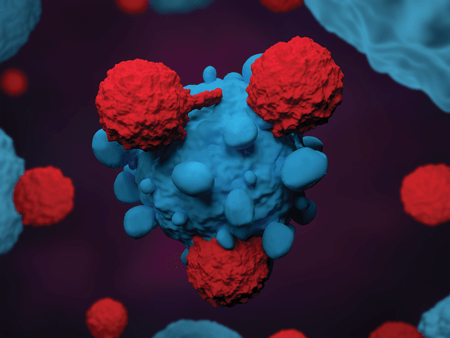Conference Puts Human Face on Cell and Gene Therapies

Cell and gene therapies will unquestionably comprise a large part of biotech companies’ portfolios in the coming decades. Unlike traditional large molecules, these products have different manufacturing and supply chain needs, requiring a fresh look at existing regulations. Yet these challenges will need to be addressed due to the promise of these products to cure a variety of diseases and disorders.
The opening talk of the 2019 PDA Cell and Gene Therapy Conference in Long Beach, Calif. on May 6 illustrated this last point in particular. Tom G. Whitehead, cofounder of the Emily Whitehead Foundation, put a human face to the often academic and technical discussion around commercialization of cell and gene therapies. At the age of five, his daughter, Emily Whitehead, was diagnosed with acute lymphoblastic leukemia (ALL). While most cases have an 85 to 90% cure rate, her case was more aggressive than usual, and she relapsed several times to the point her medical team recommended hospice care.
Her parents instead enrolled her in a Phase I clinical trial where her T-cells were reprogrammed to attack the cancer cells and then infused back into her bloodstream. Despite some initial setbacks, the therapy worked. Today, Emily remains in remission seven years later. She is recognized globally as the first pediatric patient cured via a T-cell therapy.
There was not a dry eye in the room after Whitehead finished speaking, spurring moderator and conference co-chair Michael Blackton to state: “This is the end result of our work, this is why it is important for us at PDA to collaborate together to bring these important drugs to market. This is the reason why we are here.”
The next speaker (who had a tough act to follow!), Thomas A. Leitch, Vice President, Vector Manufacturing, bluebird bio, explored what the industry needs to do to ensure patients like Whitehead’s daughter receive these therapies from the perspective of a major cell and gene therapy manufacturer.
“When I hear Tom share that amazing story, I cannot help but think what amazing times we are living in…right now there are approved cell and gene therapies that are helping transform lives,” he said. “But there is a catch…for these therapies to realize their full potential, we are going to have to find new ways to supply them in volumes greater than anything we have ever seen before.”
This requires transforming current manufacturing processes to enable manufacturing and supplying personalized batches, often within very short timeframes. This scaling challenge, Leitch emphasized, is the biggest hurdle to commercializing these lifesaving products. He cited the example of a personalized chimeric antigen receptor (CAR) T-cell therapy that requires, at a minimum, 80 staff for ten to 14 days of batch processing. That is for just one patient. The challenge occurs when that is expanded out to 10,000 patients with 400 batches ongoing at a given time. This requires almost eight million pages of documents!
“If complexity is the opposite of compliance, those numbers are going to be hard to sustain,” Leitch said.
In bluebird’s case, for one such therapy, the company turned to a contract manufacturing organization (CMO) that had the capacity to produce a clinical batch right then and there. Following a positive outcome from this initial batch, the trial expanded, necessitating a second CMO. In preparation for commercial launch, bluebird began building its own suspension platform. As the company neared launch, bluebird brought in a third CMO but continued to build out the suspension platform in tandem. In addition, the company planned to build its own manufacturing facility.
The next session delved further into the topic of facility design. John R. Dougherty, Lead Process Engineer, DPS Group, explained how his firm designed a flexible gene therapy manufacturing site using a process-centered design. He explained that a “flexible” facility can mean different things to different manufacturers, from the capability to process multiple types of products to the ability to support both clinical and commercial batches. The second speaker in the session, Francesca McBride, Director, Regulatory Compliance, Jacobs, outlined the cGMP considerations for cell therapy facilities, specifically citing limited materials available for lot release testing, fast turnaround when it comes to administration and tracking to ensure patient-specific lots are delivered to the correct patient. Her presentation showed that designing a facility for cell therapies requires a risk-based approach to address these concerns.
EU, U.S. Regs Target CGTs
After lunch, the next two speakers reviewed regulatory requirements. For a Qualified Person (QP) perspective, QP Stephanie Verbrugghe, CEO and Founder, Farbridge Pharma Consulting, presented, “Launching Clinical Trials in Europe.” European regulatory requirements in this area fall under the EudraLex clinical trial guidelines. Manufacturing of cell and gene therapies (referred to as “advanced therapy medicinal products”) must comply with GMP guidelines geared specifically for this class of product. Batches imported into the European Union must have a manufacturing and importation authorization (MIA). The QP must audit non-EU manufacturers and QC labs and provide a declaration to the relevant regulatory body.
Steven Oh, PhD, Deputy Director, Division of Cellular and Gene Therapies, Office of Tissue and Advanced Therapies, CBER, U.S. FDA, then provided an FDA perspective on product lifecycle and CMC issues. First, when it comes to autologous products (i.e., products taken from a patient and then administered to the same patient) and allogeneic products (i.e., products with cells taken from one patient and delivered to others), there are common concerns around material qualification, establishing specifications, manufacturing facilities, manufacturing changes, supply chains, etc. For autologous products, specific challenges are product tracking and segregation, variability, limited material for testing, etc., and challenges for allogeneic products include donor eligibility, cell bank qualification, reproducibility of cell banks, scale up, etc.
In the face of these challenges, product characterization is critical.
“Product characterization should occur throughout the lifecycle, but it is expected that investment is made at the early stage of product development as this becomes very important as you start making manufacturing changes,” Oh said.
The last session of the first day delved into the product characterization process. Brendan G. Keenan, PhD, Associate Director Quality Control Sciences and Technology, bluebird bio, started off the session with a look at analytical methods.
“There’s still the expectation that any methods supporting your proprietary material would be validated,” he explained, regardless of whether the product is a traditional biologic or a cell and gene therapy.
After Keenan’s presentation, Tam Soden, PhD, Senior Director and Head of Analytical Development, Kite, reviewed analytical characterization for patient materials, highlighting potency method development in particular. She compared the process to Beethoven’s 7th symphony, which weaves together both deep and light music in one piece.
CGT Companies Build Their Toolbox
Day 2 of the conference began with a look at applying quality risk management (QRM) principles to cell and gene therapies. For the first talk, Marsha Steed, Director Global QC Microbiology and Contamination Control, bluebird bio, covered microbial risk assessments for cell and gene therapies. She pointed to the recent EU Annex 1 revision that outlines use of QRM principles in manufacturing. At bluebird, the company relies on a tool called Hazard Analysis and Critical Control Point (HACCP). Steed recognized that companies may prefer to use different tools but emphasized the importance of “doing it well as patients need us to.”
HACCP is a globally recognized solution for reducing hazard risk, originating in World War II and developed by Pillsbury for the U.S. space program. Since the 1970s, FDA has mandated that the food industry use HACCP following botulism cases due to improperly canned foods. HACCP is a qualitative risk assessment technique that “is a systematic, preventive approach to identify hazards in a process and/or system with the aim to produce a documented plan to control these hazards.” The tool uses risk ranking and analysis and requires a hazard analysis and determining critical control points, which are then monitored extensively.
Michael Long, PhD, Senior Director Consulting Services, ValSource, then covered a similar risk assessment tool, the Interventions Risk Evaluation Model (IREM). This tool ranks the risk of interventions serves as a kicking off point. The IREM was showcased in the PDA Letter in 2016 (1).
The next two sessions looked at raw material selection and control and supply chain challenges. All of these sessions emphasized that while there are significant raw material and supply chain challenges within the growing cell and gene therapy market, there are tools available to help address them.
At the close of the conference, Blackton referred back to Whitehead’s power talk.
“Everything we do here results into some outcome for the patient,” he said. “What we are doing is going to translate to people having better lives.”
Reference
- Baseman, H., et al. “A Line of Sight Approach for Assessing Aseptic Processing Risk: Part I.” PDA Letter 52 (June 2016) 22-29.


